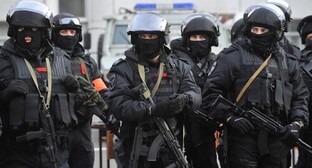21 April 2003, 12:36
Geographic position and natural resources of Chechen Republic
Chechen Republic borders in the west on Ingushetia, in the northwest - on North Ossetia, in the east - on Dagestan, in the north - on Stavropol Territory. In the south there is external state border with Georgia. The territory of the republic expands from the north to the south for 170 km and from the west to the east almost for 100 km. Distance from Grozny to Moscow - 2007 km.
Between Chechen Republic and Republic of Ingushetia there is no official demarcation border. After Chechnya was separated from Checheno-Ingush ASSR in 1991 and unilaterally proclaimed its independence and until present time the delimitation of borders was not performed. In 1992 the two republics agreed that "conditionally" the border between Chechnya and Ingushetia passes along the administrative borders between the regions of the former Checheno-Ingush ASSR. Thus Ingushetia received 3 regions (approximately 17% of the territory) and Chechnya - 11 regions (83% of the territory) of the former Autonomous Republic that had the area of 19.3 thousand sq km. Parts of Malgobeksky and Sunzhensky regions are disputable territories that both Chechens and Ingush believe to be theirs by the right of origin. For this reason there are still discrepancies in the definition of the area of both Chechen Republic (from 15.5 to 17 thousand sq km) and Republic of Ingushetia.
By relief Chechen Republic is divided into lowland northern part and highland southern part. The highland part of Chechnya - northern slopes of the Large Caucasus Mountains, they occupy 35% of the territory. The remaining 65% of the territory are cultivated plains, steppe and semi-desert: Chechen plain and Tersko-Kumskaya lowland. Chechen plain in natural state is steppe with small forest-steppe parts. Its large part is ploughed up and used in agriculture, since the soils here are fertile chernozem, less often - chestnut and light chestnut. Tersko-Kumskaya lowland in the main semi-desert territory covered with sagebrush and saltwort, and humidified areas are steppe covered by mat-grass and fescue. The vegetation in the mountains varies according to altitude: up to 2200 m there are broad-leaved forests with valuable species of wood - beech, oak, hornbeam, higher - sub-Alpine and Alpine meadows. Mountain valleys have a lot of good pastures for cattle. The climate is continental, with average temperatures in January from -3 to -5?C on the plain, to -12?C in the mountains, and in July from +21 to +25?C. Large rivers - Terek and Sunzha with the tributary Argun, having large reserves of hydraulic power.
In general the natural climate conditions are favourable for life of the population. The climate of the highland area has healing balneal properties. The ecological situation till the middle of the 90-s remained moderately difficult and was connected mostly with contamination of water and soils and soil erosion. Now the ecological condition of the region is extremely unfavourable: the consequences war and the work of primitive oil refining mini-plants have produced an averse effect on the situation. The air and water are poisoned with petroleum waste products.
The region has high seismicity, earthquakes of 9 point intensity are possible here.
The main mineral resources are oil, gas, natural building materials, thermal and mineral waters.
The main natural resource is oil. Chechnya like Ingushetia and adjacent areas of North Caucasia belongs to the oldest oil and gas producing regions of Russia. The main oil production facilities are located around Grozny and settlement Novogroznensky. The commercial reserves of oil in Chechen Republic constitute 50 - 60 million tons, they are depleted to a great extent. The general known reserves exceed 370 million tons, but they occur in extremely unfavourable geological conditions at the depth of 4.5 - 5 km and are difficult for development. Today Chechen Republic cannot develop these fields because of the republic does not produce either drilling or field equipment and there are not enough specialists in the sphere of oil production.
The former production association "Grozneft" conducted mining of 24 oil and gas fields, the reserves of which considered to be industrial (as of January 1, 1993). 90% of the volume of initial oil reserves is extracted. The largest by residual reserves were considered Oktyabrskoye, Goriacheistochnenskoye, Starogroznenskoye, Pravoberezhnoye, Bragunskoye, Severo-Bragunskoye and Eldarovskoye fields - they produced 4/5 of the total amount of oil production. According to the results of 1998 Chechnya produced 846 thousand tons of oil, including gas condensate.
The own power resources of the republic are obviously poor. The shortage of electric power supply - approximately 40% of the needs - in the beginning of the 90-s Chechnya covered with supplied from other regions of Russia through the system of RAO UES. In 1997 Chechen Republic imported up to 60% of consumed electric power.
Chechnya has quite large reserves of power resources of the mountain rivers, however their usage is not established. The potential of geothermal waters is highly estimates by the specialists: in the 80-s it was planned to build three geothermal circular systems for heat supply of Grozny on the basis of Petropavlovsky and Khankalsky fields, but these projects were not accomplished.
Conditions for agriculture are favourable: fertility of soils, abundance of heat, large areas of natural meadow pastures - all this promotes development of plain agriculture and cattle breeding industry on mountain pastures. According to the data of the republican Ministry of Agriculture, the maximum area of arable land in the republic was in the beginning of the 90-s - 300 - 330 thousand ha, the pastures occupied 517 thousand ha, collective gardens and vineyards - more than 20 thousand ha. According to the information of the Ministry of Economy of Chechnya, in 1997 the total area of farmland in the republic was more than 1 million ha, including 34% (340 - 350 thousand ha) of arable land. We believe that pre-war data on the size of arable land are slightly exaggerated.
Source: I.G. Kosikov, L.S. Kosikova. North Caucasia: Social and Economic Reference Book




